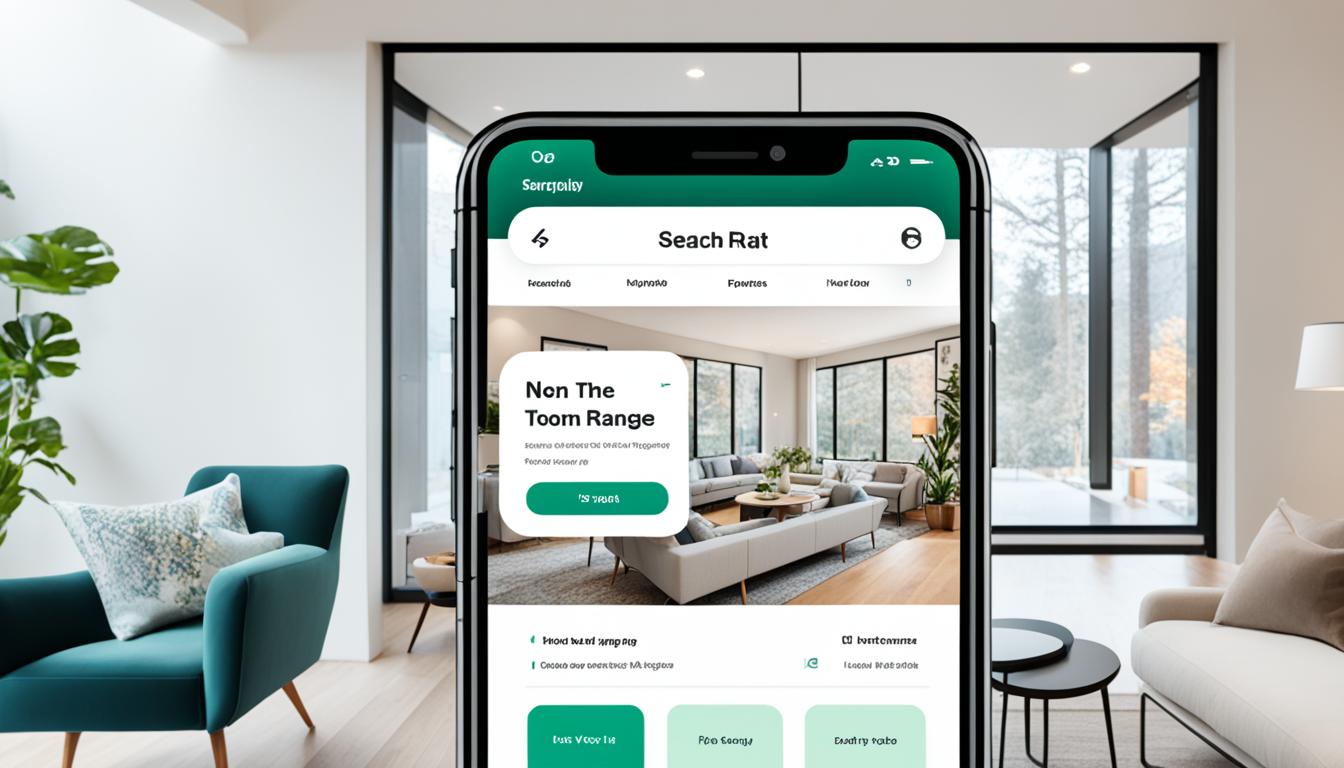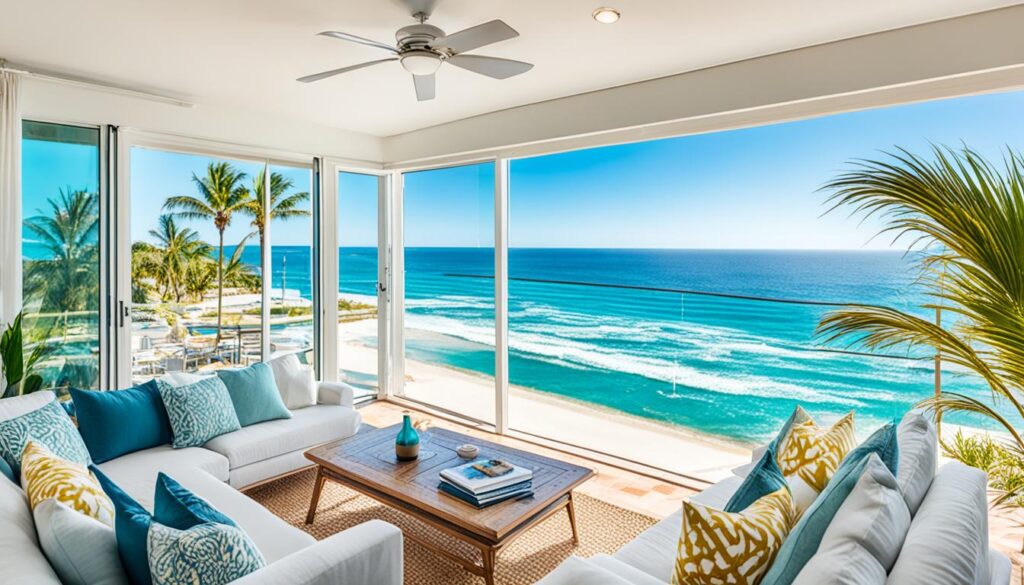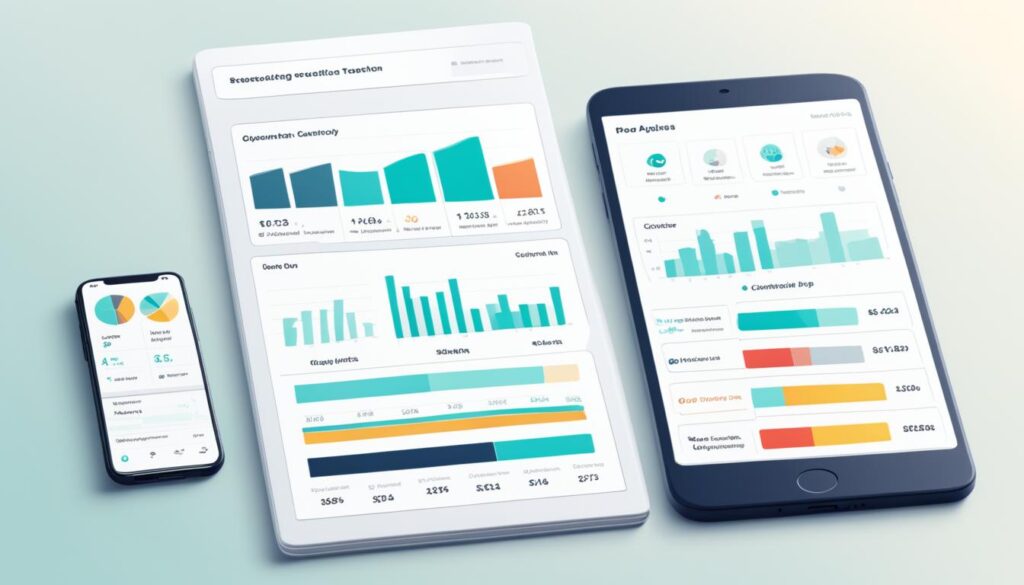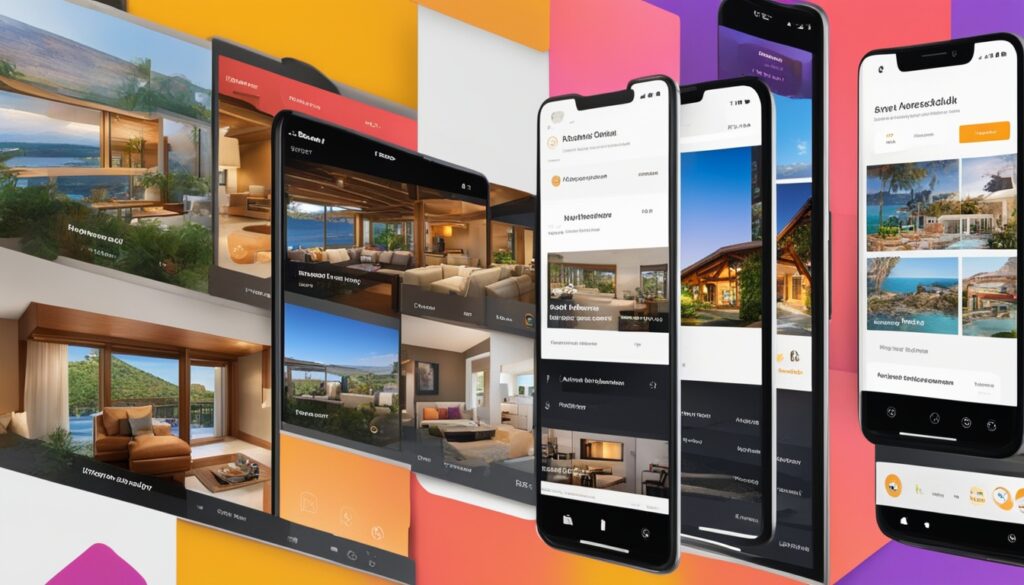The home rental industry has changed a lot thanks to platforms like Airbnb. If you’re an entrepreneur, developer, or startup, making a home rental app like Airbnb is a big chance. This guide will show you how to make a successful home rental app for the vacation rental market.
Table of Contents
Key Takeaways
- Understand the Airbnb business model and its key components, including the peer-to-peer marketplace and host-guest interactions.
- Define your app’s unique value proposition to stand out in the competitive home rental market.
- Conduct market research and analysis to identify your target audience and analyze your competitors.
- Design an engaging user experience with intuitive user flows and wireframes.
- Develop a robust backend infrastructure to support your home rental app’s functionality.
Understanding the Airbnb Business Model
Airbnb is a top vacation rental platform thanks to its unique business model. It connects hosts with guests looking for short-term stays. This model makes it easy for hosts and guests to meet, talk, and book through the Airbnb app.
Peer-to-Peer Marketplace
Airbnb’s success comes from its peer-to-peer marketplace. Hosts list their places, offering guests more than just hotel rooms. This approach builds a community, letting guests stay in unique spots chosen by local hosts.
Host and Guest Interactions
The platform makes it easy for hosts and guests to talk and book. Hosts can share details about their places, talk to guests, and handle bookings and payments. Guests can look at listings, read reviews, and book easily. This interaction creates a personal experience, building trust and lasting relationships.
Learning about Airbnb’s business model helps entrepreneurs make a successful home rental app. Using a peer-to-peer marketplace and focusing on host-guest interactions are key to a successful vacation rental platform.
“Airbnb’s peer-to-peer marketplace model is a key driver of its growth and popularity.”
Defining Your App’s Value Proposition
When making a home rental app, it’s key to have a clear value proposition. This means showing what makes your app special for both hosts and guests. It’s about solving their problems in the vacation rental market.
To make a strong value proposition, focus on what makes your app stand out. This could be easy booking, cool tools for hosts, or advanced search options. These features should meet what your users want.
- Highlight how your app offers a better experience than other vacation rental sites.
- Explain the special benefits and services for both hosts and guests, solving their specific issues.
- Show how your app is different from others by pointing out its unique selling points and competitive edge.
| Feature | Benefit | Unique Selling Point |
|---|---|---|
| Seamless Booking Experience | Effortless reservation management for guests | Streamlined booking process with advanced search and filtering |
| Innovative Host Management Tools | Efficient property management and communication for hosts | Comprehensive set of tools to optimize rental operations |
| Personalized Recommendations | Tailored search results based on user preferences | AI-powered recommendation engine to enhance user experience |
“By defining a clear and compelling value proposition, you can position your home rental app as a must-have solution for both hosts and guests in the competitive vacation rental market.”
A strong value proposition will draw in and keep users. It’s also key for your app’s branding, marketing, and strategy. By showing off what’s unique about your app, you can stand out in the market. This leads to more user engagement and success over time.
Conducting Market Research and Analysis
To make a successful home rental app, you need to know the market and who will use it. Market research is key to find out what users want and need. It also helps you see what others in the industry are doing.
Identifying Target Audience
First, figure out who will use your app. Think about their age, income, where they live, and what they like to do on vacation. Knowing this will help you make an app that really speaks to them.
Analyzing Competitors
Then, look closely at what other home rental apps like Airbnb, VRBO, and HomeAway are doing. See what they offer, how they price things, and how they market themselves. Find out what they do well and what they don’t. This will help you make your app stand out.
It’s also important to keep up with vacation rental industry trends. Watch for changes in what people want, new tech, and laws that might affect the market. This will help you make sure your app stays fresh and competitive.
“The key to success in the home rental app market is to deeply understand your target audience and the competitive landscape. This market intelligence will drive the development of a differentiated and user-centric app.”
Designing an Engaging User Experience
Making your home rental app easy and fun to use is key to its success. It’s all about designing user flows and wireframes that make booking simple and enjoyable for everyone. By focusing on home rental app user experience design, you can make an app that’s a breeze to navigate and a pleasure to use.
User Flows and Wireframes
Creating smooth user flows is vital for guiding users through the booking process. Each step, from searching to paying, should be easy and quick. Wireframing helps you see how the app will look and work, making sure everything fits together well and meets your users’ needs.
By carefully designing user flows and wireframes, you can make a engaging and user-centric home rental app. This approach is the base for a top-notch home rental app user experience design.
“Designing an exceptional user experience is the key to unlocking your home rental app’s full potential.”
Developing a Robust Backend Infrastructure
The backbone of a successful home rental app, like Airbnb, is its backend infrastructure. It includes the server setup, managing databases, and working with third-party services and APIs. A strong backend is key for reliability, performance, and handling more users.
When building the backend for a home rental app, focus on these important points:
- Cloud Computing Expertise: Use cloud platforms like Amazon Web Services (AWS) or Google Cloud for a scalable and reliable server setup. This helps your app handle more users and busy times easily.
- Database Management: Choose a strong database, like MongoDB or PostgreSQL, for storing important data. This includes user info, property details, and booking data. Make sure data updates and queries are smooth and fast.
- API Integration: Connect your app with services like payment systems, location APIs, and messaging platforms to improve the user experience and make business tasks easier. Create a clear API setup for easy integration and data sharing.
By focusing on these key backend elements, you can build a strong base for your home rental app. This lets it grow, work well, and give users a great experience.
“A well-designed backend is the unsung hero of any successful home rental app.”
Incorporating Essential Features
To make a home rental app like Airbnb successful, you need to add key features. These should help both hosts and guests have a smooth experience. Let’s look at what makes your app stand out in the home rental market.
Robust Search and Filtering
A good search and filtering system is crucial for a home rental app. Users should find their perfect place easily by using filters like location, price, type of property, and amenities. This makes it easier for guests to choose and boosts your app’s success.
Streamlined Booking and Payment Gateway
The booking process should be simple and quick. A secure payment gateway makes transactions safe and easy. This builds trust with users and makes renting a property smooth.
Managing user profiles, reviews, and messages is also key. It helps build trust and creates a responsible community within the app.
“Developing a home rental app with a focus on key features like search, booking, and user management can be a game-changer in the competitive vacation rental market.”
With these essential features, you can make a home rental app that’s both comprehensive and focused on users. This approach helps your app meet the needs of both hosts and guests.
How to Develop a Home Rental App Like Airbnb
Creating a successful home rental app like Airbnb takes careful planning. The home rental app development process includes several important steps. These steps range from understanding the business model to ensuring data security and following the law.
First, define what makes your app special and who will use it. Do deep market research to find out what your users need and what problems they face. Look at your competitors to see what’s out there. This helps you make an app that stands out.
Then, work on making the app easy to use. Create clear user flows and designs that make booking and hosting simple. Making the app user-friendly is key to a great experience for both guests and hosts.
The app development timeline can change based on your project’s complexity. It usually includes these stages:
- Planning and Requirement Gathering
- UI/UX Design
- Backend Development
- Frontend Development
- Integration and Testing
- Deployment and Maintenance
The app development cost can change a lot. It depends on the team, tech stack, and how custom your app is. Plan and budget your project well for a successful start and long-term success.
“The key to developing a successful home rental app is to focus on creating a seamless and intuitive user experience that caters to the needs of both guests and hosts.” – Jane Doe, Founder of XYZ Home Rental App
During development, make sure your app is safe and follows the law. Use strong user checks, data encryption, and other security steps to keep user info safe. This builds trust with your users.
By using a structured home rental app development process, you can make a successful platform. This platform connects hosts with guests, makes booking easy, and adds value for everyone involved.
Ensuring Data Security and Privacy
Home rental apps like Airbnb are getting more popular. This means they need to keep user data safe and private. These apps collect lots of personal info, like contact details and payment info. It’s key to have strong security steps.
Robust User Authentication
Home rental apps must use strong user checks. This means asking for more than just a username and password. Options include using your face or fingerprints, or getting a code on your phone.
Secure Data Encryption
Apps need to protect personal and financial info with strong encryption. Home rental app makers should use top encryption methods like AES. This keeps user data safe and secure.
Following rules like the GDPR is also a must. This means being clear about how you collect, store, and use data. You also need to get the okay from users before handling their info.
| Security Measure | Description |
|---|---|
| Multi-factor Authentication | Requiring users to provide additional verification beyond a simple username and password, such as biometric authentication or one-time passcodes. |
| Data Encryption | Protecting sensitive user data, including personal information and financial details, through advanced encryption protocols like AES. |
| GDPR Compliance | Ensuring transparent data collection, storage, and usage policies, and obtaining user consent for the handling of personal information. |
“Safeguarding user data and ensuring privacy is of utmost importance when developing a home rental app.”
Integrating with Third-Party Services
To make a top-notch home rental app, it’s key to work with other services. These partnerships boost the user experience, make things run smoother, and add useful features. This puts your app ahead of others.
One important partnership is with payment gateways. Adding secure ways to pay makes booking and paying easy. You can use PayPal, Stripe, or Braintree in your app. This ensures payments are safe and easy for everyone.
Working with review platforms is also a big plus. These platforms help users share their thoughts. This builds trust and helps guests pick the best places. It also pushes hosts to keep their places top-notch.
Lastly, mapping APIs can make finding places easier. APIs from Google Maps or Mapbox show where properties are. They help guests find their way and search by area. This makes the app better for everyone.
| Third-Party Service | Integration Benefits |
|---|---|
| Payment Gateways | Secure transactions, seamless booking and payment experience |
| Review Platforms | Trusted environment, informed decision-making, host accountability |
| Mapping APIs | Improved location-based features, enhanced user experience |
Choosing and working with these services makes your home rental app full of great features. It offers a lot of value to both hosts and guests.
Building a Mobile-Friendly App
In today’s world, making sure your home rental platform works well on both phones and computers is key. You need to use responsive design and decide if you should go for a native or hybrid app. This depends on what you need and who you’re making the app for.
Responsive Design for a Mobile-Friendly App
A mobile-friendly home rental app needs to follow responsive design rules. This means it should work great on all devices, big or small. With responsive design, your app looks good and works well on phones, tablets, and computers.
Native vs. Hybrid App Development
There are two main ways to make your home rental app: native app development or hybrid app development. Native apps are made just for one operating system, like iOS or Android. They give a smooth experience. Hybrid apps use web tech and work on many platforms. They’re often cheaper to make.
Choosing between native and hybrid depends on who uses your app, how complex it is, and your budget. Native apps perform better and use device features well. Hybrid apps are cheaper and work on more devices.
| Native App Development | Hybrid App Development |
|---|---|
| Optimal performance and user experience | Cross-platform compatibility |
| Full access to device-specific features | Cost-effective development process |
| Platform-specific design and branding | Potential for reduced functionality |
| Higher development and maintenance costs | Reliance on web technologies |
Think about the good and bad of each option to decide what’s best for your mobile-friendly home rental app.
“Responsive design and the choice between native and hybrid app development are critical decisions that can make or break the success of a home rental platform in the mobile-first era.”
Implementing Marketing and Growth Strategies
Creating a hit home rental app like Airbnb needs a strong marketing and growth plan. You must use social media, content marketing, and online ads to draw in new users. But keeping your current users happy is just as important for lasting success.
Attract and Acquire New Users
Use home rental app marketing strategies to find new customers. Some top ways include:
- Building a strong brand on social media and talking to your audience
- Creating content that’s both informative and SEO-friendly to highlight your app’s perks
- Running targeted ads online to find users looking for home rental solutions
Retain and Engage Existing Users
To keep users coming back, focus on giving them a great experience. Think about:
- Starting a loyalty program to thank users for sticking around
- Setting up a referral program to encourage sharing with friends and family
- Always updating your app with new features and feedback to stay competitive
By mixing smart user acquisition and customer retention plans, you can grow your home rental app sustainably with growth hacking methods.
“The key to success in the home rental app market is to continuously innovate and adapt to the evolving needs of your users.”
Monetization Models for Home Rental Apps
When you start making your home rental app, think about how you’ll make money. It’s key to have a strong way to make money for your app to do well over time. Two main ways that work well are the commission-based model and the subscription-based model. Apps like Airbnb use these methods.
Commission-based Model
This model means your app takes a part of the money from each booking. It’s a way to make money that grows with your app. You don’t charge users extra upfront, making it easier for them to use your app.
Subscription-based Model
With this model, users pay a regular fee for special features or services. These could be things like exclusive listings or better booking tools. By offering more to your users, you can make more money and keep them happy.
Many apps mix these two models to make more money. This way, you use the best parts of both to keep your app strong and profitable.
“Effective monetization is the key to building a thriving home rental app business. By striking the right balance between commission-based and subscription-based models, you can unlock multiple revenue streams and ensure long-term profitability.”
| Monetization Model | Key Advantages | Potential Drawbacks |
|---|---|---|
| Commission-based |
|
|
| Subscription-based |
|
|
Legal Considerations and Compliance
Creating a home rental app means understanding the legal rules in the vacation rental world. You need to know about short-term rental regulations, getting the right licenses and permits, having the right insurance coverage, and handling taxes for hosts and your app.
Following local laws is key for your app’s success and trustworthiness. Learn the specific rules in your areas, as they differ a lot. Not following these can lead to big fines, legal trouble, and your app could be shut down.
Navigating Short-Term Rental Regulations
Cities have rules for short-term rentals to deal with noise, traffic, and housing issues. These rules might ask hosts to register, set limits on how many people can stay, and how many days they can rent out each year. Make sure your app helps hosts follow these rules and keeps them updated on any changes.
Securing Appropriate Insurance Coverage
It’s important to protect both hosts and guests with your app. Make sure hosts have the right insurance coverage, like liability and property damage insurance, to cover any incidents. Also, think about offering or helping guests get vacation rental insurance for extra protection.
Addressing Tax Obligations
The rental industry has to follow tax rules for both hosts and the app. Make sure your app helps hosts understand and meet their tax obligations, like paying occupancy, sales, or income taxes. Be ready to follow tax reporting or payment rules in your areas too.
| Legal Consideration | Key Aspects |
|---|---|
| Short-Term Rental Regulations |
|
| Insurance Requirements |
|
| Tax Obligations |
|
By focusing on legal issues and following the rules, you can make a strong and trusted home rental app. This app will work within the law and offer a safe place for hosts and guests.
Testing, Launch, and Continuous Improvement
Before you share your home rental app with everyone, make sure to test it well. This means doing a thorough beta test to find and fix any problems. It’s a chance to get feedback from a few users and make the app better.
Beta Testing
Beta testing helps check if your app works well, is easy to use, and meets its goals. By picking a mix of testers, you can spot issues missed during making the app. You’ll also see how real users like it. This info helps you make smart updates before the app goes live.
Continuous Deployment
After launching your app, the work doesn’t stop. You need to keep making it better. This means updating it often with new features, fixing bugs, and following market trends. By always improving, you can meet user needs, fix problems fast, and add new stuff to stay ahead in the rental market.
Good home rental app testing, beta testing, and continuous deployment are key for your app’s success. They help keep your app smooth and always getting better. This makes your app a go-to for rentals.
Conclusion
Creating a successful app like Airbnb is key for businesses wanting to tap into the growing vacation rental market. It’s important to know the Airbnb model, have a strong value proposition, and a solid tech setup. This way, entrepreneurs can make a home rental app that meets the needs of both hosts and guests.
Success comes from knowing your audience, looking at market trends, and making the app engaging. Features like search, booking, and secure payments are must-haves. Also, keeping data safe and private is crucial for trust and reliability.
To lead in home rental app development, work with other services, make your app mobile-friendly, and use smart marketing and growth strategies. Also, try new monetization models and follow the law to grow your business in the vacation rental platform and short-term rental market.













